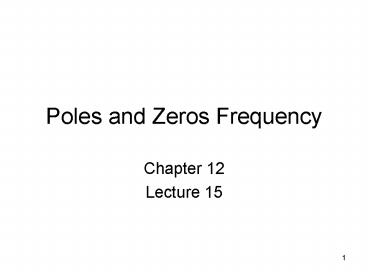Poles and Zeros Frequency - PowerPoint PPT Presentation
1 / 17
Title:
Poles and Zeros Frequency
Description:
cosOk |H[ejO]|cos(Ok H[ejO]) This says: 'the response to a sinusoid inputs is....' 3 ... We will plot on the unit circle. ... the Unit Circle (zeros don't ... – PowerPoint PPT presentation
Number of Views:60
Avg rating:3.0/5.0
Title: Poles and Zeros Frequency
1
Poles and Zeros Frequency
- Chapter 12
- Lecture 15
2
Frequency response from Poles and Zeros
- Recall z esT e(sj?)T
- And zk ? Hkzk
- So ejOk ? HejOejOk letting s 0, O ?T
- e-jOk ? He-jOe-jOk
- This is the same as
- cosOk ? HejOcos(Ok?HejO)
- This says the response to a sinusoid inputs
is.
3
Example
- Consider yk1 -0.8yk fk1
4
(No Transcript)
5
Example-cont
- Let fk cosp/6k 0.2
- Hejp/6
- Hejp/6
6
So far we have been analyzing system
responses.Lets start designing responses based
on poles and zeros
- We will plot on the unit circle.
- The closer the pole or zero is to the point ej?T,
the more affect it has on the system response. - To enhance the amplitude response at freq-?,
place a pole close to ej?T - To suppress the amplitude response at freq-?,
place a zero close to ej?T - Placing a zero on ej?T, zeros the response (notch
filter) - Placing a zero on the Origin, causes a pure delay
- All poles must lie inside the Unit Circle (zeros
dont matter)
7
- Consider H(z) bn(z-z1) (z-z2) (z-z3)
- (z-p1) (z-p2) (z-p3)
8
(No Transcript)
9
Examples
10
Examples
11
Examples
12
Examples
13
Examples
14
Examples
15
Examples
16
Examples
17
Examples































